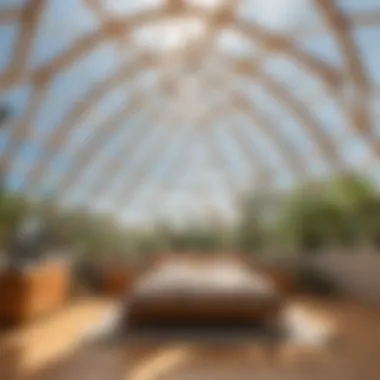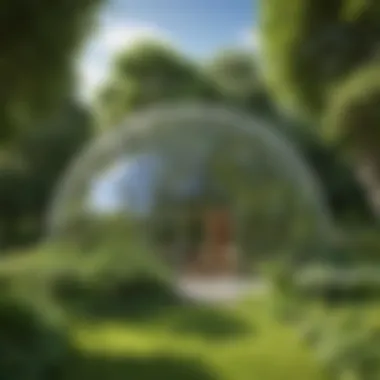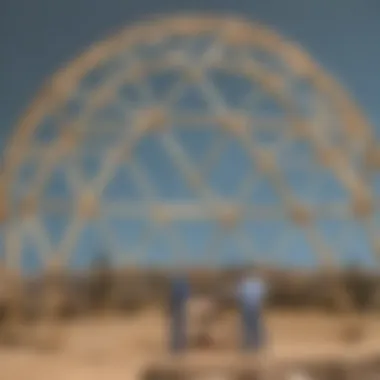Unveiling the Intriguing World of Small Geodesic Domes: A Structural Masterpiece


Science Fun Facts
Small geodesic domes are fascinating structures that stand out due to their unique design and geometric patterns. Did you know that these domes follow the principles of a geodesic polyhedron, which is derived from connecting points on a polyhedron's surface to create a network of triangles? This method contributes to their strength and efficiency in withstanding various loads. The geodesic dome concept was popularized by American engineer and architect R. Buckminster Fuller, who envisioned them as sustainable housing solutions.
Discover the Wonders of Science
Exploring small geodesic domes involves diving into various scientific concepts. These structures exemplify the principles of tensegrity, balancing compression and tension forces to create self-supporting frameworks. Educational videos and animations can visually explain how geodesic domes distribute stress evenly across their surfaces. Interactive learning tools can simulate the assembly process, enhancing understanding of the dome's construction. Real-life applications of geodesic domes span from architectural marvels to biodomes that support diverse ecosystems.
Science Quiz Time
Engage in interactive quizzes that test your knowledge of small geodesic domes. Multiple-choice questions can challenge participants to identify the key components of a geodesic dome and its advantages over traditional structures. Brain teasers may prompt critical thinking on the environmental impact of geodesic domes and their energy efficiency. Learning through gamification can make exploring geodesic domes a fun and enriching experience for learners of all ages.
Science Experiment Showcase
Get hands-on with fun and engaging experiments related to small geodesic domes. Follow step-by-step instructions to build miniature dome models using simple materials like straws and connectors. The materials list typically includes items such as cardboard, tape, and markers for customization. Safety tips and precautions ensure a smooth and secure experimentation process, promoting a safe learning environment for aspiring young architects and scientists.
Introduction to Small Geodesic Domes
Small Geodesic Domes encapsulate a captivating fusion of innovation and structural integrity within the realm of architecture. These miniature marvels offer a glimpse into the intricate world of geometric design combined with practical functionality. Exploring the foundational elements and benefits of Small Geodesic Domes sheds light on their relevance in contemporary architectural discourse, presenting a unique perspective on sustainable construction practices and spatial efficiency. Amidst the vast landscape of architectural wonders, Small Geodesic Domes stand out as testaments to human ingenuity and ecological consciousness.
Understanding Geodesic Structures


Definition and Characteristics of Geodesic Domes
At the core of Geodesic Structures lies the profound concept of interconnected triangles forming a robust framework. The defining characteristic of Geodesic Domes lies in their ability to distribute stress efficiently across the structure, resulting in unparalleled strength and durability. This unique feature makes Geodesic Domes a preferred choice for various architectural applications, showcasing elegance in design while maintaining structural resilience. The intricate patterns and geometry of Geodesic Domes offer a distinctive aesthetic appeal coupled with exceptional structural performance.
Buckminster Fuller's Contribution to Geodesic Design
The visionary architect Buckminster Fuller revolutionized architectural paradigms with his pioneering work in Geodesic Design. Fuller's innovative approaches transcended traditional building techniques, emphasizing the importance of lightweight yet remarkably sturdy structures. His contribution to Geodesic Design heralded a new era of sustainable architecture, blending artistry with engineering precision. The legacy of Buckminster Fuller continues to inspire contemporary architects to explore the vast potentials of Geodesic Domes, reflecting a harmonious coalescence of creativity and functionality.
Advantages of Geodesic Structures
The Advantages of Geodesic Structures are manifold, ranging from unparalleled strength-to-weight ratio to inherent energy efficiency. Geodesic Domes offer superior structural stability, with the ability to withstand diverse environmental conditions with minimal material usage. This sustainable approach not only reduces construction costs but also minimizes the ecological footprint, making Geodesic Structures an eco-conscious choice in modern architectural practices. The inherent adaptability and scalability of Geodesic Domes further contribute to their versatility, allowing for innovative design solutions and sustainable living spaces.
Evolution of Geodesic Domes
Historical Development of Geodesic Domes
The Historical Development of Geodesic Domes traces its origins back to groundbreaking experiments in structural engineering and geometric form. Over the centuries, architects and engineers have refined the concept of Geodesic Domes through meticulous research and experimentation. The historical significance of Geodesic Domes lies in their evolution from theoretical models to practical applications, symbolizing human perseverance and innovation in architectural design.
Notable Geodesic Dome Projects
Notable Geodesic Dome Projects scattered across the globe serve as iconic landmarks of architectural excellence and creative vision. These projects showcase the diverse applications of Geodesic Domes, ranging from futuristic event spaces to sustainable housing solutions. The unique juxtaposition of form and function in these projects exemplifies the adaptability and aesthetic appeal of Geodesic Dome construction, setting new standards for architectural innovation and structural design.
Innovations in Geodesic Dome Construction


Innovations in Geodesic Dome Construction have heralded a new era of possibilities in architectural design and engineering. The integration of advanced materials, digital tools, and sustainable practices has revolutionized the construction process, enabling architects to push the boundaries of creativity. These innovations have led to the development of lightweight, structurally efficient Geodesic Domes that embody elegance, resilience, and environmental consciousness. The future of Geodesic Dome construction is poised for further advancements, promising a blend of cutting-edge technology and timeless architectural principles.
Design and Construction of Small Geodesic Domes
In the realm of architectural ingenuity, the design, and construction of small geodesic domes stand out as a testament to structural sophistication and innovative engineering. These small-scale structures encompass a fusion of artistry and mathematical precision, creating geometric wonders that captivate the eye and serve a multitude of practical purposes. The significance of exploring the design and construction of small geodesic domes within this article lies in unraveling the intricate components that form the backbone of these unique architectural marvels. By delving into the specific elements, benefits, and considerations associated with small geodesic dome construction, we pave the way for a comprehensive understanding of the meticulous craftsmanship and thoughtful design principles behind these miniature gems.
Structural Elements of Small Geodesic Domes
Framework and Triangle Geometry
Embarking on an exploration of small geodesic domes necessitates a keen focus on the pivotal role played by framework and triangle geometry in shaping these structures. The framework acts as the skeletal foundation, providing strength and stability to the dome, while the intricate interplay of triangles forms the basis of its resilient composition. Embraced for its inherent strength-to-weight ratio and efficiency in distributing stress loads, the framework and triangle geometry showcase a harmonious blend of elegance and functionality in small geodesic domes, making them a preferred choice for architects and enthusiasts alike. The unique feature of this geometry lies in its ability to maximize interior space while minimizing materials, offering a sustainable and resource-efficient solution for compact architectural designs.
Materials Used in Small Geodesic Dome Construction
Turning our attention to the materials used in small geodesic dome construction unveils a world of versatility and durability that underscores the essence of these miniature wonders. From lightweight yet robust metals to eco-friendly wood derivatives, the materials chosen for constructing small geodesic domes strike a delicate balance between strength and environmental consciousness. Each material comes with its unique characteristics, whether it be the resilience of steel or the warmth of timber, offering architects a palette of options to manifest their creative visions. While these materials bestow unparalleled strength and aesthetic appeal to small geodesic domes, they also present challenges such as upkeep and weather resistance, demanding careful consideration during the construction phase.
Assembly Techniques for Miniature Geodesic Structures
Navigating the intricate terrain of assembly techniques for miniature geodesic structures sheds light on the process of bringing these architectural marvels to life. From the meticulous alignment of triangular panels to the precise connection of nodes, the assembly process requires a blend of precision engineering and skilled craftsmanship. The unique feature of these techniques lies in their modularity and scalability, allowing for ease of assembly and disassembly, making small geodesic domes ideal for temporary or portable applications. While these techniques offer expediency and flexibility in construction, they also present challenges related to structural integrity and long-term stability, accentuating the need for careful planning and execution in realizing these geometrical wonders.
Practical Applications and Future Prospects


Small geodesic domes offer a myriad of practical applications and exciting future prospects. Their versatility extends to various sectors, making them a valuable asset in modern architecture. From residential to commercial and educational settings, the potential of these miniature structures is boundless. Their eco-friendly nature and cost-effective construction make them a popular choice for sustainable housing solutions and innovative design projects. By integrating small geodesic domes into urban landscapes, we can revolutionize the way we live and interact with our environment.
Utilizing Small Geodesic Domes
Residential Uses of Miniature Geodesic Structures
Small geodesic domes are rapidly gaining popularity in the realm of residential architecture due to their unique design and efficiency. Their compact footprint allows for maximum use of space while providing a unique living experience. The curved walls of geodesic domes create a sense of openness and connectivity with nature, promoting a harmonious living environment. Despite their small size, these domes offer excellent insulation properties, making them energy-efficient homes. However, their unconventional shape may pose challenges in terms of interior layout and furniture placement.
Commercial Applications of Small Domes
The utilization of small geodesic domes in commercial settings opens up a world of possibilities for businesses. These structures can serve as innovative pop-up shops, exhibition spaces, or outdoor event venues, capturing the attention of customers and creating a distinct brand image. Their portable nature and quick assembly make them ideal for temporary installations or seasonal businesses. Moreover, the geometric aesthetics of geodesic domes add a contemporary flair to commercial spaces, attracting a younger demographic and fostering a sense of creativity and innovation.
Educational and Recreational Settings for Small Geodesic Designs
In educational and recreational settings, small geodesic domes offer a dynamic learning environment and a playground for creativity. These structures can be used as interactive science centers, planetariums, or outdoor classrooms, providing a unique space for experiential learning. Their visual appeal and futuristic design stimulate curiosity and engagement among students and visitors. However, the maintenance of geodesic domes in public spaces may require specialized skills and regular upkeep to ensure their longevity and functionality.
Emerging Trends and Future Developments
Innovative Solutions for Small Geodesic Habitats
The innovation surrounding small geodesic habitats is paving the way for sustainable living solutions and off-grid housing options. Researchers and architects are exploring new materials and construction techniques to enhance the durability and eco-friendliness of these structures. The integration of smart technologies and energy-efficient systems is transforming small geodesic domes into self-sustaining habitats that minimize environmental impact and maximize comfort for residents.
Technological Advancements in Mini Dome Construction
Technological advancements play a crucial role in advancing the construction and design of small geodesic domes. State-of-the-art software and manufacturing processes enable architects to create custom-built domes with precision and speed. 3D printing and robotic assembly methods streamline the construction process, reducing material waste and labor costs. Additionally, virtual reality simulations allow builders to visualize and optimize dome designs before actual construction, ensuring efficient use of resources and optimal structural integrity.
Exploring Sustainable Practices in Future Geodesic Designs
The focus on sustainability is driving the exploration of eco-friendly practices in future geodesic designs. From using recycled materials to implementing green energy solutions, architects are prioritizing environmental consciousness in dome construction. Rainwater harvesting systems, passive solar heating, and green roofs are some sustainable features being incorporated into small geodesic structures. By embracing these practices, we can create a greener future where small geodesic domes play a vital role in promoting eco-conscious living and sustainable communities.







